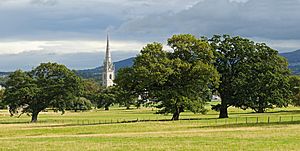Marble Church, Bodelwyddan facts for kids
St Margaret's Church is a beautiful church located in Bodelwyddan, Wales. It's often called the Marble Church because it's built with many different types of marble. You can see its tall spire from far away, as it reaches 202 feet into the sky! The church is found near the A55 main road.
The church was built by Lady Margaret Willoughby de Broke. She wanted to remember her husband, Henry Peyto-Verney. Lady Margaret started the building work on July 24, 1856. The famous architect John Gibson designed the church. It was finished and opened on August 23, 1860. Building it cost a lot of money, about £60,000. When it was new, people called it the 'Pearl of the Vale'.
Amazing Marble Church
This church is special because it uses fourteen different kinds of marble. For example, its tall pillars are made of Belgian Red marble. The entrance to the main part of the church, called the nave, uses Anglesey marble. You can also see shafts of Languedoc marble on bases of Purbeck marble.
The church also has beautiful wooden carvings. In the church tower, there are lovely stained glass windows. These windows show pictures of Saint Margaret and Saint Kentigern. Many people visit the church each year because it is so unique. In 1962, it was given a special Grade II* listed status. This means it's a very important historic building.
Over time, the church's bright white color has changed. Pollution in the air has made the marble look more grey. This makes it look more like other old stone buildings now. The area where the church is located has also changed names over the years due to government changes. It has been in Flintshire, then Clwyd, and now it is in Denbighshire.

Churchyard Stories
Right next to the church is an area that used to be Kinmel Camp. This was a military camp during the First World War. Many Canadian soldiers stayed there.
Graves of Soldiers
The churchyard is a very important place. It holds the graves of many soldiers who died during the Spanish flu pandemic in 1918–1919. This flu spread around the world and made many people sick.
In March 1919, there was a difficult event at the camp. A ship meant to take soldiers back to Canada was sent to deliver food to Russia instead. This caused some trouble at the camp. Five Canadian soldiers died during these events. Four of them are buried here in St Margaret's Churchyard. The fifth soldier was buried in Canada.
In total, 112 soldiers from the First World War are remembered here. More than 80 of these graves belong to Canadian soldiers. There are also special headstones for four British soldiers. They were originally buried somewhere else but are remembered here. Two British servicemen from the Second World War are also buried here. The churchyard also has graves from after the World Wars. One grave belongs to a Welsh Guards soldier who died during the Falklands War.


